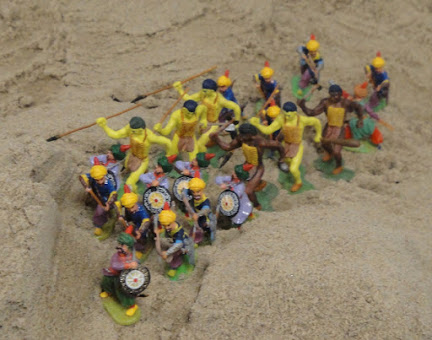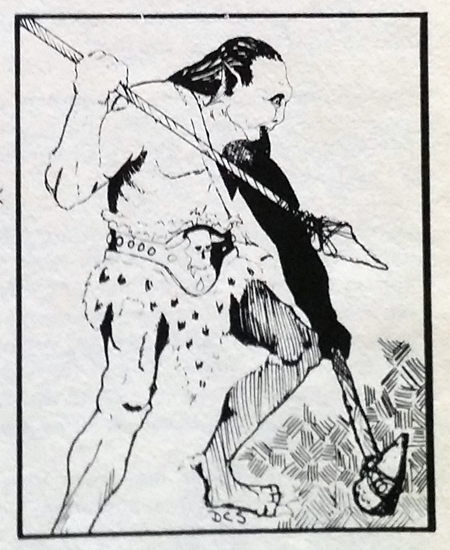Over on Against the Wicked City, Joseph Manola posted about colorful versions of classic D&D monsters — from the AD&D 1e Monster Manual (paid link).
Quick, picture an ogre. What color is it? Now check out its description from the MM:
The hide of ogres varies from dull blackish-brown to dead yellow. Rare specimens are a sickly violet in color. Their warty bumps are often of different color — or at least darker than their hides. Hair is blackish-blue to dull dark green. Eyes are purple with white pupils. Teeth are black or orange, as are talons.
Whoa! That’s not what I picture in my head when I think “D&D ogre,” but I love it.
And Joseph is right: There are lots of other monsters in the AD&D 1e MM that fall into this category — much more vividly hued that what’s come to be the default D&D version. I’d never noticed that before.
Goblins is yeller
Joseph also quoted a few other descriptions, including the one for goblins — “yellow through dull orange to brick red,” and yep, no green ones — that made me take a closer look at the back cover of the MM. And there they are — bright yellow goblins!

My copy isn’t going to win any beauty contests, but the yellow still shows up clearly. I thought maybe I was misidentifying those little dudes as goblins, but check out the lovely Trampier goblin illustration from the goblin entry:

It’s a perfect match, right down to the shape of the shield. Bright yellow goblins — awesome!
Where did the colorful ogre come from?
That made me wonder whether I’d just been missing, or perhaps glossing over, marvelously colorful ogres (and other humanoids) in other editions. Did colorful ogres start in OD&D (paid link)?
Nope:
These large and fearsome monsters range from 7 to 10 feet in height, and due to their size will score 1 die +2 (3–8) points of hits when they hit. When encountered outside their lair they will carry from 100 to 600 Gold Pieces each.
That’s the whole entry — no word on their appearance. But OD&D sometimes assumes you’re also looking at Chainmail, so let’s look there, too:
What are generally referred to as Trolls are more properly Ogres — intermediate creatures between men and Giants. They will fight in formations, and have a martial capability of six Heavy Foot.
Nope again. How about Holmes Basic?
These large and fearsome humanoid monsters range from 7 to 10 feet in height and are of various disgusting colors.
That’s interesting — “various disgusting colors.” I like that it’s left vague, but it doesn’t help pin down the origins of the violet ogre.
Okay, what about Moldvay Basic (paid link)?
Ogres are huge fearsome human-like creatures, usually 8 to 10 feet tall.
They grew a foot, but they’re back to having no reference to skin color. So where did the colorful ogre come from?
Noodling
OD&D is a short game, and light on details in many places. It wouldn’t surprise me if Gygax and Arneson didn’t both describing some creatures, like the ogre, with which they assumed folks would be familiar. Holmes and Moldvay both used OD&D as their baseline, so it makes sense that they’d leave ogres pretty much the same.
And then along comes the MM. It was written by Gary, so presumably the colorful ogre — and its brightly-hued friends — is a Gygaxian ogre, not an Arnesonian or Gygax/Arneson one. I’ve read a decent chunk of Appendix N, but I haven’t bumped into any ogres that look like this so far.
I’d love to know the answer, but I’ve got nothing. Nothing but Joseph’s original point, that is: There are some cool, wildly colorful humanoids in the AD&D MM.
I’d love to play in a game where those were the defaults — that’d be a pulpy setting with a healthy dose of zany, and I dig that.
Update
Michael Curtis has a theory about the origins of the colorful ogre, and gave me permission to share it here (including his photo). Thanks, Michael!

“When Gary and the guys were playing Chainmail with the Fantasy supplement, there wasn’t much in the way of fantastical miniatures to use as monsters and humanoid troops. Chainmail itself suggests using 25mm and 15mm figures of normal medieval troops (then readily available) to portray dwarves, halflings, goblins, etc for example.
In those games, the players used larger scale miniatures to represent the bigger monsters. One such figure was an American Indian warrior with spear and breastplate. These figure were used as ogres. Their coloration: bright yellow.
The attached photo is from Gary Con IV where they replayed the “Battle of the Brown Hills” Chainmail fantasy scenario. The game used figures dating from the early 1970s, in some cases the actual miniatures owned by the Lake Geneva crew. Here you can see the yellow warriors (and one painted dark brown) facing off against human soldiers. Compare the pose of these “ogres” to the picture in the 1st edition Monster Manual.
I can’t confirm this with 100% accuracy that this is how we got bright yellow ogres, but the pieces fit the theory.”
Here’s the ogre from the MM:

Seems like a solid theory to me!

The brightly colored Ogre seems at least more plausibly related to the Oni/Ogre Mage…
I’ve always assumed those came from Japanese folklore, but never poked into it. There are tons of weird, awesome, colorful yokai and other creatures in old folktales.
Hmm. That’s very interesting. Yeah, it seems like the AD&D description grew out of play materials like those bright yellow American Indian miniatures. I also prefer those lurid, zany color schemes.
I’d love to amass a whackadoodle assortment of weird toys and make a Monster Manual inspired solely by them.
Nice work in following this up, Martin! The yellow miniatures look like a credible source for yellow being one of the ogre colours, but unless the American Indians were also made in purple, some of the other stuff must just have been due to Gygax loving really colourful monsters…
I loved your original post! Thanks for writing it.
It was fun going back through books to see what was up, but Michael Curtis showed up and did more in a few paragraphs, off the top of his head, than I could.
Totally agree on violet ogres. I’d love to know the story there, but even without it you pointed out a whole new side of old-school D&D for me (and others) to appreciate.